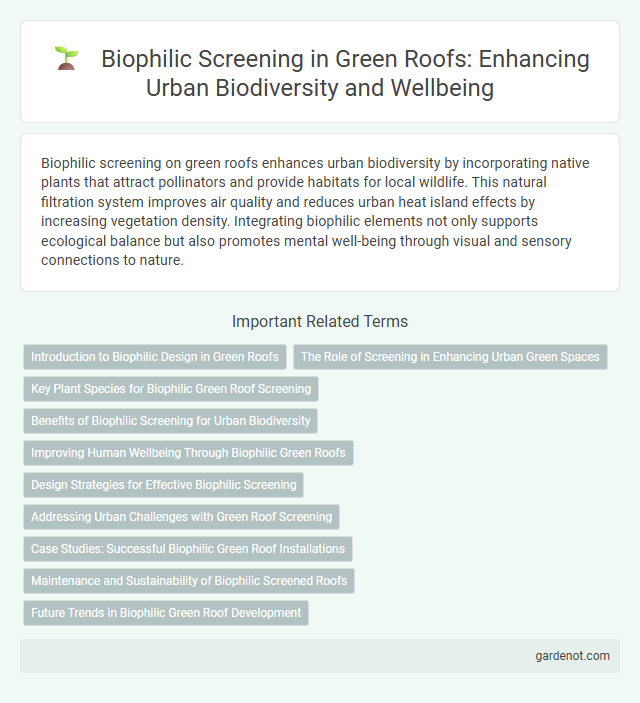Biophilic screening on green roofs enhances urban biodiversity by incorporating native plants that attract pollinators and provide habitats for local wildlife. This natural filtration system improves air quality and reduces urban heat island effects by increasing vegetation density. Integrating biophilic elements not only supports ecological balance but also promotes mental well-being through visual and sensory connections to nature.
Introduction to Biophilic Design in Green Roofs
Biophilic design in green roofs integrates natural elements that enhance urban biodiversity and human well-being, promoting a connection between building occupants and the environment. Incorporating native plant species, natural materials, and organic spatial layouts fosters ecological balance and reduces urban heat island effects. This approach supports environmental sustainability while creating visually appealing, health-promoting rooftop landscapes through biophilic screening techniques.
The Role of Screening in Enhancing Urban Green Spaces
Biophilic screening on green roofs plays a crucial role in enhancing urban green spaces by improving air quality, reducing noise pollution, and creating visual barriers that foster privacy. These living screens support biodiversity by providing habitats for birds and insects while contributing to the cooling effects necessary for mitigating urban heat islands. Incorporating native plant species in biophilic screening maximizes ecological benefits and strengthens the connection between urban residents and nature.
Key Plant Species for Biophilic Green Roof Screening
Key plant species for biophilic green roof screening include native grasses, flowering perennials, and low-maintenance succulents that enhance biodiversity and ecosystem services. Sedum varieties like Sedum album and Sedum spurium provide drought tolerance and vibrant seasonal color, supporting pollinator habitats. Incorporating species such as Carex oshimensis and Festuca glauca improves air quality and creates natural privacy while optimizing thermal regulation on green roofs.
Benefits of Biophilic Screening for Urban Biodiversity
Biophilic screening on green roofs enhances urban biodiversity by providing habitat corridors for pollinators, birds, and small mammals, supporting native plant species and promoting ecological resilience. These living green walls improve air quality and temperature regulation while increasing species richness in densely built environments. Integrating biophilic screening contributes to urban ecosystem services, fostering connectivity and biodiversity hotspots within city landscapes.
Improving Human Wellbeing Through Biophilic Green Roofs
Biophilic screening on green roofs enhances human wellbeing by integrating natural elements that reduce stress and improve air quality. The presence of native plants and natural materials promotes mental restoration and cognitive function in urban environments. Studies show that biophilic green roofs increase occupant satisfaction and contribute to overall health by fostering a stronger connection to nature.
Design Strategies for Effective Biophilic Screening
Biophilic screening integrates natural elements such as climbing plants and modular green walls into green roof design to enhance aesthetic appeal and improve air quality. Effective design strategies include selecting native, drought-resistant plant species that thrive in rooftop conditions and incorporating layered vegetation for increased biodiversity and visual interest. Optimizing screen placement for wind protection and solar shading maximizes environmental benefits while maintaining building energy efficiency.
Addressing Urban Challenges with Green Roof Screening
Green roof biophilic screening enhances urban environments by integrating living plants that improve air quality, reduce heat island effects, and support biodiversity. These green screens act as natural barriers against noise pollution and excessive sunlight, creating cooler, quieter, and more comfortable urban spaces. By incorporating native vegetation, biophilic screening fosters ecological connections and promotes mental well-being in densely built cities.
Case Studies: Successful Biophilic Green Roof Installations
Biophilic screening integrates natural elements into green roof designs to enhance urban biodiversity and improve microclimate regulation. Notable case studies include the Bosco Verticale in Milan, where vertical forestation on green roofs supports bird habitats and air purification. Another successful example is Singapore's Marina Bay Sands, which employs biophilic screening to reduce building energy consumption while promoting occupant well-being.
Maintenance and Sustainability of Biophilic Screened Roofs
Biophilic screened green roofs require regular maintenance to ensure plant health, including pruning, irrigation management, and pest control, which enhances their longevity and ecological benefits. Sustainable practices such as using native, drought-resistant species and incorporating automated irrigation systems reduce water consumption and maintenance costs. These strategies support biodiversity, improve energy efficiency, and contribute to urban heat island mitigation while maintaining the structural integrity of the roof.
Future Trends in Biophilic Green Roof Development
Emerging biophilic screening techniques in green roof development emphasize integrating native plant species to enhance biodiversity and improve urban microclimates. Advanced sensor technologies facilitate real-time monitoring of plant health and environmental impact, promoting adaptive maintenance strategies. Future trends prioritize sustainable materials and modular designs that support ecological connectivity and resilience in urban landscapes.
Biophilic screening Infographic

 gardenot.com
gardenot.com